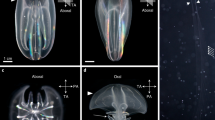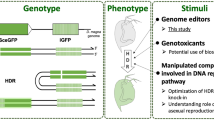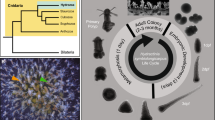Abstract
The sea anemone Nematostella vectensis is a model system used by a rapidly growing research community for comparative genomics, developmental biology and ecology. Here, we describe a microinjection procedure for creating stable transgenic lines in Nematostella based on meganuclease (I-SceI)-assisted integration of a transgenic cassette into the genome. The procedure describes the preparation of the reagents, microinjection of the transgenesis vector and the husbandry of transgenic animals. The microinjection setup differs from those of previously published protocols by the use of a holding capillary mounted on an inverted fluorescence microscope. In one session of injections, a single researcher can microinject up to 1,300 zygotes with a reporter construct digested with the meganuclease I-SceI. Under optimal conditions, fully transgenic heterozygous F1 animals can be obtained within 4–5 months of the injections, with a germ-line transmission efficiency of ∼3%. The method is versatile and, after a short training phase, can be carried out by any researcher with basic training in molecular biology. Flexibility of construct design enables this method to be used for numerous applications, including the functional dissection of cis-regulatory elements, subcellular localization of proteins, detection of protein-binding partners, ectopic expression of genes of interest, lineage tracing and cell-type-specific reporter gene expression.
This is a preview of subscription content, access via your institution
Access options
Access Nature and 54 other Nature Portfolio journals
Get Nature+, our best-value online-access subscription
$29.99 / 30 days
cancel any time
Subscribe to this journal
Receive 12 print issues and online access
$259.00 per year
only $21.58 per issue
Buy this article
- Purchase on Springer Link
- Instant access to full article PDF
Prices may be subject to local taxes which are calculated during checkout



Similar content being viewed by others
References
Genikhovich, G. & Technau, U. The starlet sea anemone Nematostella vectensis: an anthozoan model organism for studies in comparative genomics and functional evolutionary developmental biology. Cold Spring Harb. Protoc. http://dx.doi.org/10.1101/pdb.emo129 (2009).
Steele, R.E., David, C.N. & Technau, U. A genomic view of 500 million years of cnidarian evolution. Trends Genet. 27, 7–13 (2011).
Technau, U. & Steele, R.E. Evolutionary crossroads in developmental biology: Cnidaria. Development 138, 1447–1458 (2011).
Technau, U. et al. Maintenance of ancestral complexity and non-metazoan genes in two basal cnidarians. Trends Genet. 21, 633–639 (2005).
Putnam, N.H. et al. Sea anemone genome reveals ancestral eumetazoan gene repertoire and genomic organization. Science 317, 86–94 (2007).
Tulin, S., Aguiar, D., Istrail, S. & Smith, J. A quantitative reference transcriptome for Nematostella vectensis early embryonic development: a pipeline for de novo assembly in emerging model systems. Evodevo 4, 16 (2013).
Kusserow, A. et al. Unexpected complexity of the Wnt gene family in a sea anemone. Nature 433, 156–160 (2005).
Lee, P.N., Pang, K., Matus, D.Q. & Martindale, M.Q. A WNT of things to come: evolution of Wnt signaling and polarity in cnidarians. Semin. Cell Dev. Biol. 17, 157–167 (2006).
Rentzsch, F., Fritzenwanker, J.H., Scholz, C.B. & Technau, U. FGF signalling controls formation of the apical sensory organ in the cnidarian Nematostella vectensis. Development 135, 1761–1769 (2008).
Layden, M.J., Boekhout, M. & Martindale, M.Q. Nematostella vectensis achaete-scute homolog NvashA regulates embryonic ectodermal neurogenesis and represents an ancient component of the metazoan neural specification pathway. Development 139, 1013–1022 (2012).
Saina, M., Genikhovich, G., Renfer, E. & Technau, U. BMPs and chordin regulate patterning of the directive axis in a sea anemone. Proc. Natl. Acad. Sci. USA 106, 18592–18597 (2009).
Wikramanayake, A.H. et al. An ancient role for nuclear beta-catenin in the evolution of axial polarity and germ layer segregation. Nature 426, 446–450 (2003).
Ikmi, A., McKinney, S.A., Delventhal, K.M. & Gibson, M.C. TALEN and CRISPR/Cas9-mediated genome editing in the early-branching metazoan Nematostella vectensis. Nat. Commun. 5, 5486 (2014).
Kraus, Y., Aman, A., Technau, U. & Genikhovich, G. Pre-bilaterian origin of the blastoporal axial organizer. Nat. Commun. 7, 11694 (2016).
Park, F. Lentiviral vectors: are they the future of animal transgenesis? Physiol. Genomics 31, 159–173 (2007).
Wittlieb, J., Khalturin, K., Lohmann, J.U., Anton-Erxleben, F. & Bosch, T.C. Transgenic Hydra allow in vivo tracking of individual stem cells during morphogenesis. Proc. Natl. Acad. Sci. USA 103, 6208–6211 (2006).
Kawakami, K. Tol2: a versatile gene transfer vector in vertebrates. Genome Biol. 8 (Suppl. 1), S7 (2007).
Pavlopoulos, A., Oehler, S., Kapetanaki, M.G. & Savakis, C. The DNA transposon Minos as a tool for transgenesis and functional genomic analysis in vertebrates and invertebrates. Genome Biol. 8 (Suppl. 1), S2 (2007).
Ran, F.A. et al. Genome engineering using the CRISPR-Cas9 system. Nat. Protoc. 8, 2281–2308 (2013).
Sternberg, S.H. & Doudna, J.A. Expanding the biologist's toolkit with CRISPR-Cas9. Mol. Cell 58, 568–574 (2015).
Ishibashi, S., Love, N.R. & Amaya, E. A simple method of transgenesis using I-SceI meganuclease in Xenopus. Methods Mol. Biol. 917, 205–218 (2012).
Khalturin, K. et al. Transgenic stem cells in Hydra reveal an early evolutionary origin for key elements controlling self-renewal and differentiation. Dev. Biol. 309, 32–44 (2007).
Siebert, S., Anton-Erxleben, F. & Bosch, T.C. Cell type complexity in the basal metazoan Hydra is maintained by both stem cell based mechanisms and transdifferentiation. Dev. Biol. 313, 13–24 (2008).
Nakamura, Y., Tsiairis, C.D., Ozbek, S. & Holstein, T.W. Autoregulatory and repressive inputs localize Hydra Wnt3 to the head organizer. Proc. Natl. Acad. Sci. USA 108, 9137–9142 (2011).
Fritzenwanker, J.H. & Technau, U. Induction of gametogenesis in the basal cnidarian Nematostella vectensis(Anthozoa). Dev. Genes Evol. 212, 99–103 (2002).
Thermes, V. et al. I-SceI meganuclease mediates highly efficient transgenesis in fish. Mech. Dev. 118, 91–98 (2002).
Grabher, C., Joly, J.S. & Wittbrodt, J. Highly efficient zebrafish transgenesis mediated by the meganuclease I-SceI. Methods Cell Biol. 77, 381–401 (2004).
Ogino, H., McConnell, W.B. & Grainger, R.M. Highly efficient transgenesis in Xenopus tropicalis using I-SceI meganuclease. Mech. Dev. 123, 103–113 (2006).
Pan, F.C., Chen, Y., Loeber, J., Henningfeld, K. & Pieler, T. I-SceI meganuclease-mediated transgenesis in Xenopus. Dev. Dyn. 235, 247–252 (2006).
Wang, Y. et al. The meganuclease I-SceI containing nuclear localization signal (NLS-I-SceI) efficiently mediated mammalian germline transgenesis via embryo cytoplasmic microinjection. PLoS One 9, e108347 (2014).
Bevacqua, R.J. et al. Simple gene transfer technique based on I-SceI meganuclease and cytoplasmic injection in IVF bovine embryos. Theriogenology 80, 104–113.e1-29 (2013).
Fernandez-Martinez, L.T. & Bibb, M.J. Use of the meganuclease I-SceI of Saccharomyces cerevisiae to select for gene deletions in actinomycetes. Sci. Rep. 4, 7100 (2014).
Cohen-Tannoudji, M. et al. I-SceI-induced gene replacement at a natural locus in embryonic stem cells. Mol. Cell Biol. 18, 1444–1448 (1998).
Choulika, A., Perrin, A., Dujon, B. & Nicolas, J.F. Induction of homologous recombination in mammalian chromosomes by using the I-SceI system of Saccharomyces cerevisiae. Mol. Cell Biol. 15, 1968–1973 (1995).
Choulika, A., Perrin, A., Dujon, B. & Nicolas, J.F. The yeast I-Sce I meganuclease induces site-directed chromosomal recombination in mammalian cells. C R Acad. Sci. III 317, 1013–1019 (1994).
Ochiai, H., Sakamoto, N., Suzuki, K., Akasaka, K. & Yamamoto, T. The Ars insulator facilitates I-SceI meganuclease-mediated transgenesis in the sea urchin embryo. Dev. Dyn. 237, 2475–2482 (2008).
Renfer, E., Amon-Hassenzahl, A., Steinmetz, P.R. & Technau, U. A muscle-specific transgenic reporter line of the sea anemone, Nematostella vectensis. Proc. Natl. Acad. Sci. USA 107, 104–108 (2010).
Nakanishi, N., Renfer, E., Technau, U. & Rentzsch, F. Nervous systems of the sea anemone Nematostella vectensis are generated by ectoderm and endoderm and shaped by distinct mechanisms. Development 139, 347–357 (2012).
Richards, G.S. & Rentzsch, F. Transgenic analysis of a SoxB gene reveals neural progenitor cells in the cnidarian Nematostella vectensis. Development 141, 4681–4689 (2014).
Layden, M.J., Rentzsch, F. & Rottinger, E. The rise of the starlet sea anemone Nematostella vectensis as a model system to investigate development and regeneration. Wiley Interdiscip. Rev. Dev. Biol. 5, 408–428 (2016).
Belfort, M. & Roberts, R.J. Homing endonucleases: keeping the house in order. Nucleic Acids Res. 25, 3379–3388 (1997).
Rouet, P., Smih, F. & Jasin, M. Introduction of double-strand breaks into the genome of mouse cells by expression of a rare-cutting endonuclease. Mol. Cell Biol. 14, 8096–8106 (1994).
Doyon, J.B., Pattanayak, V., Meyer, C.B. & Liu, D.R. Directed evolution and substrate specificity profile of homing endonuclease I-SceI. J. Am. Chem. Soc. 128, 2477–2484 (2006).
Moure, C.M., Gimble, F.S. & Quiocho, F.A. The crystal structure of the gene targeting homing endonuclease I-SceI reveals the origins of its target site specificity. J. Mol. Biol. 334, 685–695 (2003).
Chiarle, R. et al. Genome-wide translocation sequencing reveals mechanisms of chromosome breaks and rearrangements in B cells. Cell 147, 107–119 (2011).
Layden, M.J., Rottinger, E., Wolenski, F.S., Gilmore, T.D. & Martindale, M.Q. Microinjection of mRNA or morpholinos for reverse genetic analysis in the starlet sea anemone, Nematostella vectensis. Nat. Protoc. 8, 924–934 (2013).
Genikhovich, G. & Technau, U. Induction of spawning in the starlet sea anemone Nematostella vectensis, in vitro fertilization of gametes, and dejellying of zygotes. Cold Spring Harb. Protoc. 2009, pdb prot5281 (2009).
Ogino, H., McConnell, W.B. & Grainger, R.M. High-throughput transgenesis in Xenopus using I-SceI meganuclease. Nat. Protoc. 1, 1703–1710 (2006).
Schwaiger, M. et al. Evolutionary conservation of the eumetazoan gene regulatory landscape. Genome Res. 24, 639–650 (2014).
Layden, M.J. et al. MAPK signaling is necessary for neurogenesis in Nematostella vectensis. BMC Biol. 14, 61 (2016).
DuBuc, T.Q. et al. In vivo imaging of Nematostella vectensis embryogenesis and late development using fluorescent probes. BMC Cell Biol. 15, 44 (2014).
Green, M.R. & Sambrook, J. Molecular Cloning. A Laboratory Manual (Cold Spring Harbor Laboratory Press, 2012).
Gibson, D.G. Synthesis of DNA fragments in yeast by one-step assembly of overlapping oligonucleotides. Nucleic Acids Res. 37, 6984–6990 (2009).
Technau, U., Kraus, J.E.M. & Genikhovich, G. Cnidaria. in Evolutionary Developmental Biology of Invertebrates, Vol. 1 (ed. Wanninger, A.) (Springer, 2015).
Ikmi, A. & Gibson, M.C. Identification and in vivo characterization of NvFP-7R, a developmentally regulated red fluorescent protein of Nematostella vectensis. PLoS One 5, e11807 (2010).
Acknowledgements
We thank the members of the Technau lab, in particular M. Martinussen, W. Prunner, G. Sageder and W. Göschl, for animal husbandry. We are grateful to B. Zimmermann for help with the statistics in Figure 3, A. Demilly for providing photos for Figure 2h,i and A. Cole for critically reading the manuscript. This work was supported by grants from the Austrian Science Fund FWF to U.T. (P 27353, P 25993 and P 24858).
Author information
Authors and Affiliations
Contributions
U.T. conceived the paper. E.R. generated the data and took photos. E.R. and U.T. wrote the paper.
Corresponding author
Ethics declarations
Competing interests
The authors declare no competing financial interests.
Rights and permissions
About this article
Cite this article
Renfer, E., Technau, U. Meganuclease-assisted generation of stable transgenics in the sea anemone Nematostella vectensis. Nat Protoc 12, 1844–1854 (2017). https://doi.org/10.1038/nprot.2017.075
Published:
Issue Date:
DOI: https://doi.org/10.1038/nprot.2017.075
This article is cited by
-
NvPrdm14d-expressing neural progenitor cells contribute to non-ectodermal neurogenesis in Nematostella vectensis
Nature Communications (2023)
-
An ancestral Wnt–Brachyury feedback loop in axial patterning and recruitment of mesoderm-determining target genes
Nature Ecology & Evolution (2022)
-
The architecture and operating mechanism of a cnidarian stinging organelle
Nature Communications (2022)
-
Insights into how development and life-history dynamics shape the evolution of venom
EvoDevo (2021)
-
Transgenesis in Hydra to characterize gene function and visualize cell behavior
Nature Protocols (2019)
Comments
By submitting a comment you agree to abide by our Terms and Community Guidelines. If you find something abusive or that does not comply with our terms or guidelines please flag it as inappropriate.



